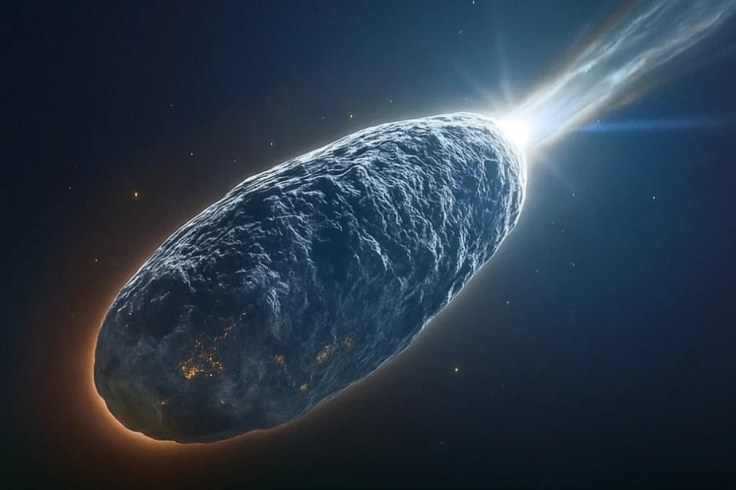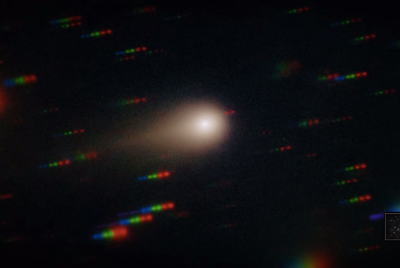Harvard's Avi Loeb Claims 3I/ATLAS Could Be 'Artificial' If No Gas Cloud Seen
The debate pits natural variability against the possibility of alien technology

Could a celestial traveller visiting our solar system be artificial? That startling possibility has been raised by Harvard's controversial astrophysicist, Avi Loeb. The object in question, 3I/ATLAS, appears to be a comet but may defy expectations.
Loeb's provocative hypothesis is simple, if the object fails to show a detectable gas cloud, it challenges a natural explanation. If the standard comet 'tail' is missing, he argues, the scientific community must confront the idea that we might be observing alien technology.
The Arrival of an Interstellar Visitor
The interstellar comet 3I/ATLAS has seized the attention of astronomers globally since the ATLAS survey team first identified it in Rio Hurtado, Chile, on 1 July 2025. It holds the official designation as the third confirmed object from outside our solar system to pass through.
This celestial body is distinct from typical comets within our system, which are held in orbit by the Sun's gravity. Instead, 3I/ATLAS hails from beyond our Sun's reach, the heliosphere, believed to have been flung out from a different star system, possibly billions of years ago.
Its path confirms its non-solar-system birth: the trajectory is hyperbolic, meaning its speed exceeds the rate needed to escape the Sun's gravity (at times hitting speeds of up to 244,600 km/h). This velocity confirms its place in the exclusive group of interstellar objects, or ISOs.
It follows in the wake of the previous two confirmed visitors: 1I/' Oumuamua, which looked like an asteroid and displayed no visible cloud, and 2I/Borisov, which behaved like a standard comet by releasing gas.
The way the comet is named —'3I' because it's the third interstellar object, and 'ATLAS' after the discovery team — shows its importance as a way to study the chemistry and motions of things outside our solar system.
READ MORE: 3I/ATLAS Survived Perihelion as Single Body — Harvard's Loeb Questions Its Origin
READ MORE: 3I/ATLAS: Harvard's Loeb Urges NASA To Release 40-Day-Old HiRISE Images Amid Global Intrigue
An Unconventional Celestial Body
Estimates suggest its central body, or nucleus, measures between 0.44 and 5.6km across (meaning its mass is at least 33 billion tons if it is solid).4 This makes 3I/ATLAS significantly bigger and heavier than the previous interstellar comet, 2I/Borisov.
Its closest pass to the Sun, known as perihelion, occurred on 29 October 2025, at approximately 1.36 AU away. This was the key moment when the Sun's heat became stronger, resulting in the unusual behaviours that have been observed.
'The surface area required to account for the mass flow in the large-scale jets — extending out to a million kilometres (620,000) towards the Sun in an image obtained on Monday — is untenable', the researcher told The Post. 'Given the solar power per unit area, the jets require an object larger than Manhattan Island.'
New 3i/ATLAS image from the Nordic Optical Telescope 11th Nov 2025 pic.twitter.com/lvum2EYbNg
— Bertiesghost (@Bertiesghost411) November 13, 2025
He added, 'A large surface area can be provided by breaking up the object [into] many fragments. But this does not appear to be the case from the latest image obtained by the Nordic Optical Telescope.'
The Enigma of Non-Gravitational Acceleration
The non-gravitational acceleration stands out as one of the most fascinating traits, initially highlighted by Davide Farnocchia, a navigation engineer at NASA's JPL.1 Observations made using ALMA revealed a 4 arcsecond shift in the object's path (right ascension) compared to what gravity alone predicted.
🚨Post-Perihelion Update - 3I/ATLAS
— MystVibe (@Myst_Vibe) November 9, 2025
The interstellar object has officially passed perihelion - but something impossible just happened.
It's showing non-gravitational acceleration and has deviated by 4 arcseconds from its expected orbit.
That's not a small error - it means 31/… pic.twitter.com/r41BVXMMR2
This revealed an additional force at work, equivalent to 0.02 mm/s² over 50 days, resulting in a velocity change of 86 m/s. This boost involves two movements: a radial push moving it away from the Sun (135 km/day²) and a tangential nudge (60 km/day²).
In a typical, naturally formed comet, this kind of movement is generally caused by the 'rocket effect'—thrust created when ice melts, or sublimates, and unevenly ejects gas and dust into space.
The Rocket Effect or Something Else?
Recent research, including a study that analysed information from ALMA and the IAWN (International Asteroid Warning Network), suggests the ejection of volatile materials causes this acceleration.
Calculations based on the principle of momentum conservation indicate the comet would need to shed material equivalent to between 13% and 16% of its total mass to account for the observed change in path.
The close-up's on 3I/ATLAS from the newest image show no tail only geometry that we would not see in a comet! This is the best image yet from NASA Lowell Discovery in happy Jack, AZ, east of Sedona, AZ. pic.twitter.com/F0NQYP0Trv
— Bobby Howe 🇺🇸 (@LFXRBobbyHowe) November 8, 2025
This material would also require an evaporation half-life of approximately six months when exposed to sunlight. Despite these expectations, the first observations taken after its closest approach to the Sun showed no large, visible coma or typical comet tail, raising doubts about how efficiently this outgassing process is truly working.
Unconventional Colour and Activity
The comet's changing colour provides more insight into its behaviour. Before its closest approach, it looked reddish, but during the pass, it became a deep blue. This shift is unusual for comets, which typically appear redder as dust scatters light.
This blue colour might be due to ionised carbon monoxide (CO) emissions — gas excited by the Sun's radiation — rather than being dominated by dust. Furthermore, the comet suddenly grew brighter just before perihelion, which suggests a large amount of material was rapidly ejected.
🚨 Webb just confirmed it: 3I/ATLAS is not behaving like any comet ever seen.
— Skywatch Signal (@UAPWatchers) August 26, 2025
A blood-red CO₂ coma, a possible 46 km core, and a missing water tail.
This breaks the models. 🧵👇 pic.twitter.com/NPl1TzUQKl
It also displayed an 'anti-tail' pointing toward the Sun for several weeks before appearing to reverse direction. While uncommon, this phenomenon is understood to be caused by viewing angle and the size distribution of the dust particles it releases.
Anomalies Challenging Conventional Models
Despite these attempts to explain the movements, 3I/ATLAS still shows a range of anomalies that defy standard theories. Harvard astronomer Avi Loeb has identified nine specific oddities.
These include its orbit close to the solar system's plane (the ecliptic), which is seldom seen in computer simulations, and the fact that its closest pass to the Sun occurred at the exact time it was hidden behind the Sun (solar conjunction).
🚨 Tomorrow Could Change Everything! 👽☀️
— Ezee (@EzeemmaCraic) October 28, 2025
On Oct 29, 2025, the mysterious interstellar object 3I/ATLAS reaches its closest point to the Sun — what Harvard astrophysicist Dr. Avi Loeb calls “the acid test.”
If it’s just a comet, it’ll burn and vaporize. But if it’s… pic.twitter.com/V8uYbyxk24
Further puzzles are its unusual size and speed — it is a million times the mass of 'Oumuamua and twice as fast — and its peculiar makeup (high levels of CO2 and nickel, but little iron or water).
Additionally, it has displayed negative light polarisation, which is entirely new for a comet, and has had jets of material spraying in multiple directions but without forming a continuous tail.
READ MORE: Avi Loeb Calculates 3I/ATLAS is One in 100 Million Chance of Being Natural
READ MORE: 3I/ATLAS Loses Comet-Like Tail and Gains Rounded Form — Experts Urge Careful Analysis
The Claim for Artificial Propulsion
Loeb argues that if subsequent observations planned for December 2025 do not reveal a gas cloud consistent with the necessary material loss, the acceleration must then point toward artificial propulsion. This argument mirrors the earlier controversy surrounding 'Oumuamua, which also sped up without any detectable release of gas.
🚨 BREAKING: NASA GOES DARK AS 3I/ATLAS DEFIES GRAVITY ☄️
— Ezee (@EzeemmaCraic) October 31, 2025
Harvard’s Avi Loeb just dropped a cosmic bombshell — new data shows 3I/ATLAS didn’t follow gravity at perihelion… it accelerated sideways. 🤯
Something pushed this interstellar object beyond sunlight and physics itself.… pic.twitter.com/bdggRCQ716
The Case for Natural Variability
Counterarguments, however, stress the idea of natural variability. Interstellar objects like this, having been exposed to powerful galactic cosmic rays over vast stretches of time, may develop hard surfaces altered by radiation. These tough exteriors could then trap volatile materials in pockets, causing sudden, unpredictable bursts of gas instead of a consistent, steady release.
The presence of high C02 and metal vapours could be explained by the comet forming in a star system rich in carbon when it was young (protoplanetary disk).
Additionally, the anti-tail and the patterns of the jets have been observed in other comets, such as Hale-Bopp and 67P/Churyumov-Gerasimenko.
The observed shifts in the spin rate — figured out by looking at how the brightness changes — are probably the result of the uneven turning force (torque) caused by these same material jets.
Broader Implications and Future Outlook
The broader significance of 3I/ATLAS extends to all studies of interstellar objects. Its chemical makeup suggests that a variety of environments exist outside our solar system, which could provide new insights into theories on how planets form.
Its unique light polarisation and metal signatures might indicate that the object has been altered by cosmic rays or the remnants of exploded stars (supernovae). Future data from NASA's ExoMars TGO, ESA's Hubble, and land-based observatories such as Keck will be critical for testing predictions about mass loss.
If no debris plume is visible by December 2025, the debate will undoubtedly intensify. However, the evidence available now still points towards a natural, though highly unusual, comet.
Conclusion: Deeper Scientific Scrutiny
In conclusion, although the acceleration of 3I/ATLAS initially perplexed observers, more recent research using radio spectroscopy and dynamic modelling offers a coherent, natural explanation.
This outcome underscores the importance of interdisciplinary work in astronomy, which necessitates balancing empirical data with new theoretical ideas.
Ultimately, it serves as a reminder that the universe's apparent 'strangeness' frequently gives way once subjected to deeper scientific examination.
© Copyright IBTimes 2025. All rights reserved.





















